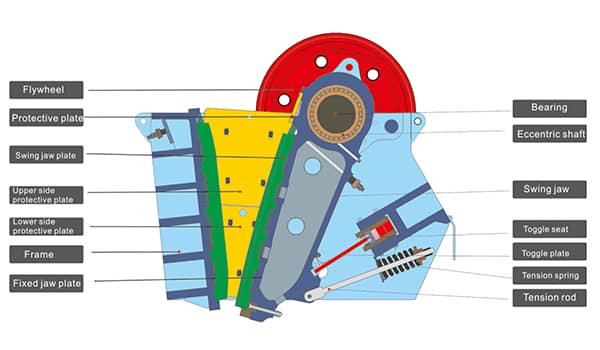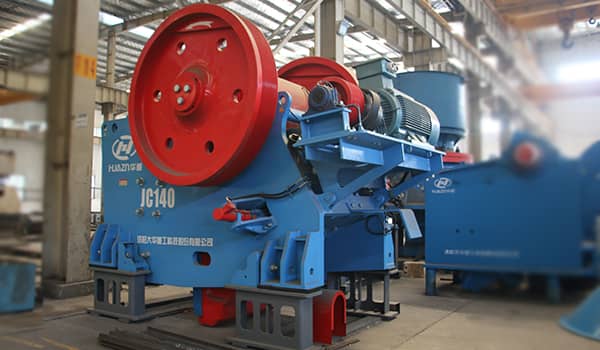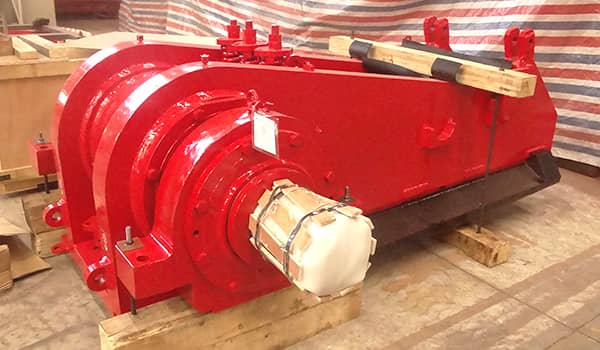Failure Analysis of Jaw Crusher
author:dahua time:2019-08-27
Jaw crusher is the key crusher equipment for stone crushing production. Many customers will meet various kinds of fault problems during production process, which will affect the whole production schedule. Here, Luoyang Dahua summarizes the common failure and treatment of the jaw crusher.
A.The main engine stops suddenly
Failure cause:
1) blocking of discharge opening, resulting in blocking of stock bin;
2) the triangular rubber belt that drives the groove wheel is too loose, causing the rubber belt to slip;
3) eccentric shaft fixed bushing is loose, resulting in no clearance on both sides of the bearing seat of the frame, making the eccentric shaft stuck and unable to rotate;
4) bearing damage.
Solutions:
1) clear the materials at the discharge opening to ensure smooth discharge;
2) tighten or replace triangle tape;
3) reinstall or replace the fixed bushing;
4) replace the bearing.
B.The main engine sheave and movable jaw work normally, but the crushing work stops
Failure cause:
1) tension spring breaks;
2) fracture of pull rod;
3) the bracket falls off or breaks.
Solutions:
1) replace the tension spring;
2) replace the tie rod;
3) reinstall or replace the bracket

C.The output is not up to factory standard
Failure cause:
1) the hardness or toughness of the broken material exceeds the range specified in the operation manual;
2) the reverse connection of the motor power makes the main engine start in reverse (clockwise rotation of the movable jaw), or the triangle connection of the motor power is mistakenly connected to the star connection;
3) the size of discharge opening is smaller than the specified limit;
4) the jaw plate is displaced, and the tooth tip of the movable jaw and the fixed jaw is opposite;
5) low voltage at work site;
6) the clearance is too large after the movable jaw and bearing are worn, causing the outer ring of the bearing to rotate.
Solutions:
1) replace the crusher;
2) replace the wiring of the motor;
3) adjust the discharge opening to the size specified in the manual, or add a crusher for fine crushing;
4) check the tooth pitch size of the tooth plate. If it is not up to standard, replace the jaw plate; Adjust the relative position of fixed jaw plate and movable jaw plate, and fix and press tightly after the tooth tip is opposite to the tooth root to prevent displacement.
5) adjust the working field voltage to meet the host's requirements of heavy load;
6) replace the bearing and jaw
D.Jump or bump sound appears when the movable and the fixed jaw plate work
Failure cause:
1) the fastening bolt of the jaw plate is loose or falls off;
2) the discharge opening is too small and the bottom of the two jaw plates collide with each other.
Solutions:
1) tighten or replenish bolts;
2) adjust the discharge opening to ensure the correct gap between the two jaw plates.
E. Eccentric shaft bending or breaking
Failure cause:
1) the main engine turns over in the lifting process, making the eccentric shaft bent under unilateral force;
2) the hardness of the broken material exceeds the requirements of the product operating instructions;
3) long-term overload operation of the main engine;
4) the toggle plate does not meet the standard. When the non-broken material enters into the crushing cavity, it can play the role of self-breaking protection;
5) improper heat treatment of eccentric shaft leads to stress concentration and short-term fracture.
Solutions:
1) replace the new eccentric shaft and properly lift the main engine;
2) choose suitable crusher according to the compressive strength of crushing materials;
3) adjust the operating load or use a suitable crusher;
4) use toggle plate and its pad that meet design standards;
5) replace the eccentric shaft after correct heat treatment.
F.Movable jaw fracture
Failure cause:
1) intensive porosity and other serious defects were left in the casting of the movable jaw;
2) using unqualified toggle plate and pad, the crusher fails to provide self-breaking protection when the toggle plate is subjected to strong impact;
3) the movable jaw displaces in the frame, and one end and the bottom collide with the guard plate on the side of the frame;
4) failure to timely replace the pull rod spring after failure;
5) the size of discharge opening is smaller than the specified limit;
6) the feeding position is not right, and the angle of feeding is too steep, so that the material directly hits the moving jaw head.
Solutions:
1) replace the movable jaw;
2) replace the original toggle plate and its pad produced;
3) properly assemble eccentric shaft, bearing, fixed bushing and movable jaw, and replace damaged parts;
4) replace the pull rod spring;
5) adjust the size of discharge opening as required;
6) increase the feeding hopper to ensure that the material blanking is uniform and smooth, and split from the middle to both sides.
G.Excessive temperature rise in housing or movable jaw
Failure cause:
1) lack of bearing oil or too much oil is injected;
2) oil hole is blocked, oil cannot be added;
3) the position of the weight block of the flying wheel runs out of place, and the frame jumps out;
4) axial movement of fixed bushing;
5) bearing wear or cage damage;
Solutions:
1) timely and quantitative refueling according to the instructions;
2) clean up blockages on oil holes and oil grooves;
3) adjust the position of the weight block of the flywheel;
4) tighten the fixing bushing;
5) replace bearings;
6) replace the end cover and sealing sleeve, or loosen the upper bearing cover at the heating end of the bearing seat of the frame, and then use a fuse as a gasket and insert cover to press into the bearing seat of the frame, and then fix the upper bearing cover to eliminate the rotation of the insert cover
H.The flywheel oscillates from side to side in an axial direction
Failure cause:
1) the hole of flying wheel, eccentric shaft or flat key wear, causing loose coordination;
2) the stone rolled into the inner side of the flying wheel, causing cracking of the wheel shell of the flying wheel;
3) the flying wheel has casting defects;
4) loose expansion sleeve of flying wheel.
Solutions:
1) if the flat key is worn, replace the flat key, or replace the eccentric shaft, flywheel;
2) add protective cover of flying wheel, and replace eccentric shaft or flying wheel;
3) replace the flywheel;
4) re-tighten the expanding sleeve.
Previous Article:Luoyang Dahua PFL Vertical Complex Crusher(Sand Making Machine)
Next Article: Crusher Application in Iron Ore Productions




